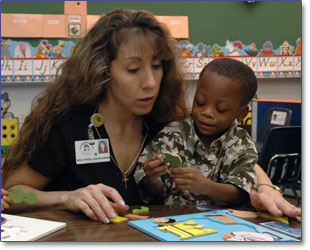  (Page 2 of 7) (Page 2 of 7)
Ask a Question
Next, ask a question. Questions
that can’t be answered with "yes"
or "no" encourage children to talk.
You might follow a child’s response with
another question that requires even more information.
For example, if the child responds “I am
building roads to the city,” you might ask,
“What will the people see when they drive
on your roads to the city?” Or “What
will the people do when they get to the city?”
Respond and Add
Finally, respond by adding
a little more. When a young child responds, his/her
answer may be very short. By repeating what the
child says and adding a little more, you are
showing the child a new way of saying something.
If you ask the child what kind of signs
the people will see on the way to the city and
he/she answers “McDonalds®,” simply
saying “People do see McDonalds® signs
on almost every highway” demonstrates
for the child another way of answering. If you
ask,
“Where are the cars?” and the child
answers, “The road,” you can respond
by saying, “Yes, the cars are on the
road.”
Follow the Child's Lead
Remember, keep the focus of your conversation
on the meaning of what the child is saying, not
whether or not the child is saying everything perfectly.
Children’s language will grow and improve
as they are included in conversations. If you want
a child to talk, you need to follow the child’s
lead. This means that you need to talk about what
the child is interested in at that moment. It might
be about something he is looking at or something
he is doing.
 |
| |
 |
It’s
easy to extend language in a one-on-one conversation
with a child, but how can you accomplish this
with a group of children? One way is to improve
whole group conversations by making sure children
do most of the talking and that many children
participate. Try to open a group conversation
by suggesting a topic and pausing to listen to
children’s responses.
You could try saying something like, “I
noticed how foggy it was this morning on the
way to school” and pausing to encourage
children to respond to your comment. A comment
encourages children to think and respond in
a way that is different from responding to questions
that require answers. As children contribute
to the conversation, try saying things like, “Hmmmm,” or
“That’s interesting,” or just
nodding your head and then looking to another
child for a response. This helps to keep the
conversation going and open to all children.
Another way to extend children’s
language is through explicit
instruction. Some
children have a hard time learning new words or
sentence structures without explicit teaching.
You may want to incorporate explicit instruction
and practice when you notice children who are not
demonstrating some of the language competencies
listed in the prekindergarten standards.
A pitfall to beware: teachers have a tendency
to do too much of the talking. Monitor yourself
when you sit and stay, or
lead
open conversation with the group.
Make sure children do more of the talking than
you do.
|